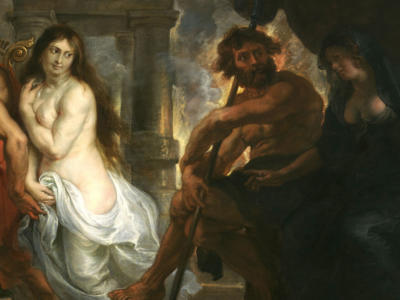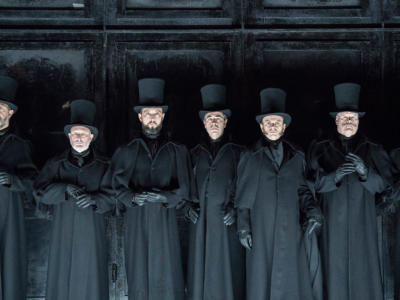Operas based on books
Composers have long taken inspiration from literature for their operas. From novels to novellas, find out more about the literary sources from some of the best-known works in the repertoire.
The Handmaid's Tale
Margaret Atwood’s The Handmaid’s Tale
Video
Margaret Atwood‘s dystopian novel, The Handmaid’s Tale was published in 1986.
The story is set in a 21st century North American society in which ecological and political disruption have led to the dismantling of the United States by a right-wing theocracy which takes over to create the new Republic of Gilead. In Gilead, women are denied the right to work or possess property, to read or write. Furthermore, the birth-rate has plummeted so all women of child-bearing age living ‘in sin’ or second marriages have been forcibly separated from their families and sent off to indoctrination centres.
There the women become Handmaids, to be posted to selected childless households and ritually impregnated by the husband in the presence of his wife.
The structure of the opera is divided into two parts, each of the acts builds up into a big scene. In Act I, the big scene is Birth, in Act Two it’s Death,and the conclusion is quiet and tense.
The opera makes two significant changes to the novel’s narrative. Firstly, the symposium on Gilead, which only occurs at the end of the book, actually opens and closes the opera. Secondly, Offred was split into two characters (both mezzo-sopranos) who depicted this young woman before and after becoming a Handmaid.
The Turn of the Screw
Henry James’ The Turn of the Screw
Video
Henry James’s chilling ghost story, The Turn of the Screw was published in 1898. It was first published weekly in a magazine over 12 weeks, then it was later published as a novel.
The story is of an unnamed governess, who has to protect two children as they experience strange encounters at a remote country house.
Composer Benjamin Britten had known Henry James’s short story The Turn of the Screw on which the opera is closely based since his teens. He had noted in his diary listening to a BBC radio broadcast of ‘a wonderful, impressive but terribly eerie and scary play “The Turn of the Screw” by Henry James’, and then the following year he read James’s ‘glorious and eerie’ novella, which he considered ‘an incredible masterpiece’.
Myfanwy Piper, a friend and collaborator of Britten, suggested The Turn of the Screw as suitable for operatic treatment. The opera debuted in Venice, Italy in 1954. The British premiere was given by Sadler’s Wells Opera who were later renamed the English National Opera.
Bizet's Carmen
Prosper Mérimée’s Carmen
Video
When approached by Paris’s Opera-Comique theatre to compose a brand new piece, it was Georges Bizet proposed turning Prosper Merimee’s novella into an opera.
First published in 1845 Mérimée’s Carmen is inspired by a six-month visit to Spain in 1830. Set in southern Spain, the novella focuses on the young, flirtatious Gypsy, Carmen and hot-blooded corporal, Don Jose. The pair meet at the cigarette factory where Carmen works, when Don Jose arrests Carmen for aggressive behavior. The leading characters then embark on an unhealthy and tumultuous relationship. Their love affair comes to a dramatic end when Don Jose kills Carmen in a jealous rage.
This tale of obsession and murder, which Bizet follows closely in his opera, came as a surprise to Opera-Comique theatre audiences on the opening night who were used to a lighter opera style performed. The composer was only 36 when Carmen premiered, and wouldn’t live to see it become a success. Bizet died suddenly just a few months in to the run.
The Dead City
Georges Rodenbach’s Bruges-la-Morte
Video
Korngold’s best known work The Dead City (also known as Die tote Stadt) is based off a 1892 novel by Georges Rodenbach titled Bruges-la-Morte. The novel is notable for two reasons, the first of which being the first work of fiction to be accompanied by photographs in lieu of illustrations, showing real places in the city of Bruges. The second being its ever-growing reputation as the archetypical Symbolist novel – a movement in the late 19th Century seeking to depict universal truths symbolically through art.
A haunting tale, The Dead City follows the recently bereaved, Paul, as he is haunted by visions of his deceased wife Marie. When an opera company rolls into town, he meets the all-too-familiar Marietta, a dancer within the troupe. The lines between past and present begin to blur, and reality itself is called into question, as this vision of his dead wife haunts his waking nightmares.
Puccini's Madam Butterfly
John Luther Long’s Madame Butterfly
Video
Published at the turn of the 20th century, the short story Madame Butterfly was written by American lawyer and writer John Luther Long.
The story tells the tale of the young geisha Cho-Cho San who marries American Naval Officer Lieutenant Pinkerton during his stay in Japan. We soon learn that Pinkerton only wanted the marriage to be temporary, and so remarries upon his return to America. Cho-Cho San, unaware of this, waits for him, hoping he will return to see his newly born son. Cho-Cho San eventually finds out about Pinkerton’s new wife and rushes home to end her life with her father’s sword. Before she can inflict the fatal blow, she is stopped by her maid, Suzuki.
Giacomo Puccini saw David Belasco’s play, based on Long’s story, in 1900. He soon enlisted the help of librettists Luigi Illica and Giuseppe Giacosa to adapt the tale into his next successful opera. In true operatic fashion, Puccini, unlike Long, ended his version in tragedy. When the Butterfly (as she is known) finds out Pinkerton wants to take her son back to America to be raised with his new wife, she ends her own life.
Thanks to Tosca and La bohème, Puccini was already one of the Italian opera greats. Although Madam Butterfly’s La Scala opening night was something of a disaster, it joined its predecessors as another triumph, thanks to Puccini’s revisions.
Donizetti's Lucia di Lammermoor
Walter Scott’s The Bride of Lammermoor
Video
Set in Scotland’s Lammermuir hills, Sir Walter Scott’s The Bride of Lammermoor is about the love affair of Lucy Ashton and her family rival, Edgar. When Edgar leaves Scotland to continue his political activity in France, Lucy is tricked into marrying the Lord of Bucklaw instead. On their wedding night, driven to madness, Lucy stabs her husband and then herself dies. The following day, having learned of Lucia’s fate, Edgar rushes to confront the Ashtons but falls into quicksand and dies.
With love affairs, murder and rivalry, Scott’s nineteenth century novel was the perfect source for operatic treatment. Librettist Salvadore Cammarano loosely based his Italian-language libretto on Scott’s historical novel, substituting the English names in the novel for their Italian counterparts (Lucy into Lucia). He also decided to change Edgar’s accidental death into a suicidal one, and add in the famous Act III mad scene.
Lucia di Lammermoor is perhaps most famous for the third act’s ‘mad scene’, in which Lucia descends into insanity. The mad scene was a popular convention in the bel canto era of opera, especially amongst French and Italian composers including Gaetano Donizetti.
Glass's The Perfect American
Peter Stephan Jungk’s Der König von Amerika
Video
Peter Stephan Jungk’s novel, Der König von Amerika (The King of America), a meditative account of Walt Disney’s last days, was composer Philip Glass’s source for his Teatro Real commission in 2013.
Jungk’s novel is an imagined biography of Walt Disney, as told by a cartoonist who – before being fired – worked for him in the 40s and 50s. The fictional narrator, Wilhelm Dantine, deeply hurt by his dismissal, follows Disney around during his last few months, trying to work out what makes him tick. Dantine’s depictions of Disney paint him in an unfavourable light, contradicting his pristine public image.
With a history of operas based on famous men – Satyagraha (Mahatma Gandhi), Akhnaten (Akhenaten), Einstein on the Beach (Albert Einstein) – Jungk’s novel seems like the perfect fit for Glass. In 2013, the opera had its UK premiere at ENO.


